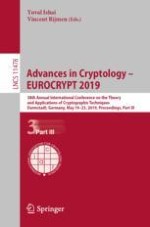2019 | OriginalPaper | Buchkapitel
Quantum Lightning Never Strikes the Same State Twice
verfasst von : Mark Zhandry
Erschienen in: Advances in Cryptology – EUROCRYPT 2019
Aktivieren Sie unsere intelligente Suche, um passende Fachinhalte oder Patente zu finden.
Wählen Sie Textabschnitte aus um mit Künstlicher Intelligenz passenden Patente zu finden. powered by
Markieren Sie Textabschnitte, um KI-gestützt weitere passende Inhalte zu finden. powered by
Abstract
-
We demonstrate the usefulness of quantum lightning beyond quantum money by showing several potential applications, such as generating random strings with a proof of entropy, to completely decentralized cryptocurrency without a block-chain, where transactions is instant and local.
-
We give Either/Or results for quantum money/lightning, showing that either signatures/hash functions/commitment schemes meet very strong recently proposed notions of security, or they yield quantum money or lightning. Given the difficulty in constructing public key quantum money, this suggests that natural schemes do attain strong security guarantees.
-
We show that instantiating the quantum money scheme of Aaronson and Christiano [STOC’12] with indistinguishability obfuscation that is secure against quantum computers yields a secure quantum money scheme. This construction can be seen as an instance of our Either/Or result for signatures, giving the first separation between two security notions for signatures from the literature.
-
Finally, we give a plausible construction for quantum lightning, which we prove secure under an assumption related to the multi-collision resistance of degree-2 hash functions. Our construction is inspired by our Either/Or result for hash functions, and yields the first plausible standard model instantiation of a non-collapsing collision resistant hash function. This improves on a result of Unruh [Eurocrypt’16] which is relative to a quantum oracle.
